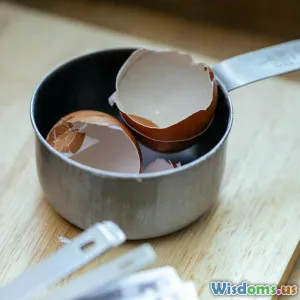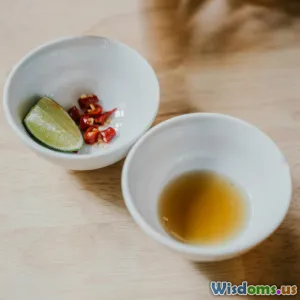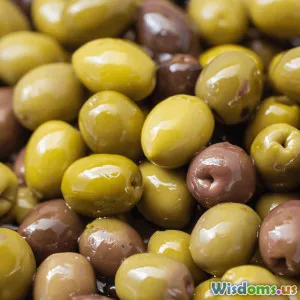
Creative Ways to Use Leftovers
7 min read Discover inventive and practical ways to transform your leftovers into delicious, waste-free meals that save money and spark creativity. (0 Reviews)
Creative Ways to Use Leftovers: Transform Food Waste into Culinary Treasures
Food waste is a global problem. According to the Food and Agriculture Organization of the United Nations, roughly one-third of the food produced worldwide is wasted, amounting to about 1.3 billion tons annually. Leftovers often head straight into the trash due to lack of inspiration or time. But what if leftovers could become the foundation for new, exciting meals? This article unlocks creative and practical ways to transform leftovers into delightful dishes, saving money and reducing waste simultaneously.
Why Embrace Leftovers?
Firstly, it’s important to understand why leftover utilization matters. The environmental cost of food waste is tremendous, contributing to greenhouse gases and wasting natural resources. Economically, throwing away food wastes hard-earned money from grocery budgets. Personally, repurposing leftovers enhances cooking skills and adds flair to routine meals.
As Chef Alice Waters wisely puts it, "The best leftovers are those transformed into an entirely new experience."
1. Reinvent as Vibrant Stir-Fries and Bowls
Stir-fries are a kinetic way to revive leftovers. Almost any cooked vegetable or meat fits well. Here’s a simple approach:
- Base: Use leftover rice, quinoa, or any grain.
- Veggies: Toss in roasted vegetables or steamed greens.
- Protein: Add shredded chicken, tofu cubes, or bites of beef.
- Sauce: Whisk together soy sauce, garlic, ginger, and a dash of honey.
A real-world example: In a New York City community kitchen, chefs rescued tons of unsold grilled vegetables by tossing them into stir-fries, offering low-cost, nutritious meals to locals.
Pro Tip:
For an added crunch, sprinkle toasted nuts or seeds just before serving.
2. Transform Leftover Bread into Delightful Dishes
Bread often goes stale but holds great potential:
- Croutons: Dice stale bread and toast with olive oil and herbs for salad toppers.
- Bread Pudding: Combine torn bread pieces with eggs, milk, sugar, and spices for a classic dessert.
- Panzanella Salad: Soak chunks of bread with tomatoes, cucumbers, onions, basil, olive oil, and vinegar.
Bread pudding alone reduces bread waste significantly across many households. According to a UK survey, nearly 20% of purchased bread is discarded, yet this recipe captures that potential.
3. Puree Leftover Veggies into Soups or Sauces
Vegetables on the brink of wilting are perfect candidates for purees.
- Toss carrots, potatoes, zucchini, or squash with vegetable broth.
- Blend until smooth with seasoning.
This creates nutrient-rich soups in minutes. Plus, homemade vegetable purees can be frozen for future use. One inspiring example is the zero-waste restaurant Silo in Brighton, UK, whose signature broth is made entirely from root vegetable trimmings.
Try mixing purees into pasta sauces for an extra nutritional punch and silky texture.
4. Bake Leftover Vegetables into Frittatas and Quiches
Egg-based dishes are ideal for combining varied leftovers.
- Whisk eggs, add diced vegetables, cooked meats, and cheese.
- Pour into a skillet or pie crust, then bake or cook stovetop.
Not only are these dishes satisfying and protein-rich, but they also allow endless customization. In Mediterranean cuisine, frittata-making is a time-honored tradition of using last night’s leftovers creatively.
5. Bake Savory or Sweet Leftover Muffins
Desperately looking for a snack idea? Turn mashed potatoes, chopped herbs, or even fruit bits into muffins.
- Combine leftovers with flour, eggs, and a leavening agent.
- Bake in muffin tins.
Example: Sweet muffins made from leftover mashed pumpkin or savory ones loaded with bits of bacon and cheese have become popular at farmers’ markets.
Studies have shown that transforming leftovers into portable snacks reduces impulse buying of packaged products, promoting healthier habits.
6. Ferment or Pickle Excess Produce
Beyond immediate cooking, consider preserving surplus vegetables through fermentation or pickling.
- Kimchi or sauerkraut recipes utilize cabbage and radishes.
- Quick pickles can be made from cucumbers or carrots using vinegar and spices.
These processes enhance flavors, improve gut health, and provide long-lasting uses for fresh produce. Fermentation is an ancient food preservation method, scientifically proven to increase microbial biodiversity in our diet.
Final Thoughts: Rethinking Leftovers as Valuable Assets
Turning leftover food into new meals demands a mindset shift: leftovers aren’t scraps, but starting points for culinary exploration. Whether it’s converting yesterday’s roast chicken into fragrant stir-fry or stale bread into crispy croutons, creativity will yield satisfying, economical results.
Next time you face a fridge full of remnants, remember—each leftover has the potential to become a delicious surprise rather than waste. Starting small today can lead to greater sustainability tomorrow.
Let your kitchen become a playground where leftover magic happens!
References and further reading:
- FAO Food Waste Report, United Nations
- "Zero Waste Chef" blog insights on food repurposing
- Bright ideas from sustainable restaurants like Silo, Brighton
Rate the Post
User Reviews
Popular Posts





















